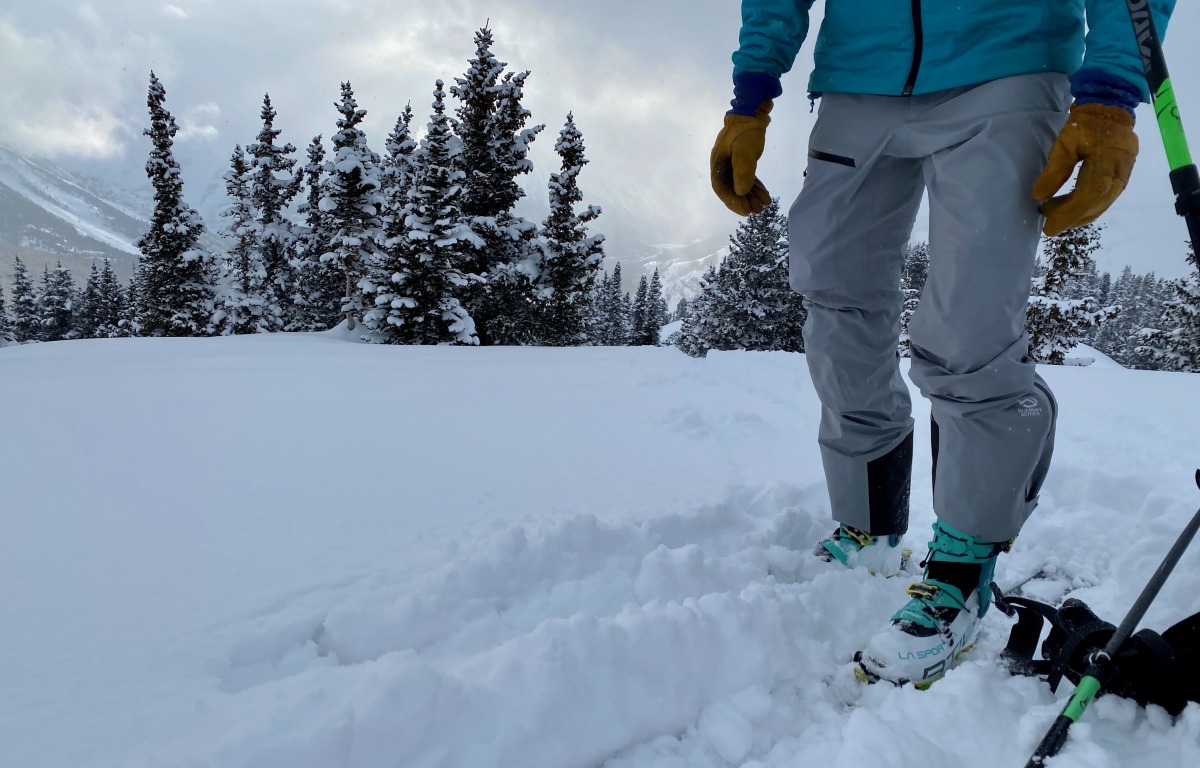
The La Sportiva Sytron — a boot that can double duty for long mountain missions or skimo training days.
I would walk 500 miles and I would walk 500 more… Too often when ski touring, but most especially when training, that song gets lodged in my head. Only I sometimes replace “miles” with “feet”, vertical feet, as I hamster up a slope, rip skins, ski down, skin up, repeat.
This winter I walked many of those vertical feet in the La Sportiva Sytron, a lightweight ski mountaineering shoe designed for maximum uphill efficiency but also decent downhill performance. Here’s my take after a long winter of training days.
Perhaps thanks to my German engineer predecessors, I’m intrinsically drawn to models of efficiency particularly when it comes to lightweight gear for moving farther into the mountains. Training is fun and all, but it’s essentially done in the service of being fit for bigger days and longer objectives when snow conditions allow. So I was particularly excited to get my foot into a boot that had similar ambitions — light enough for routine skimo training and rec racing, but substantial enough to take on some big objectives. Enter, the La Sportiva Sytron.
Last spring, Alex Lee gave an initial take on the Sytron. I’ll add to that with a long term view specifically oriented to lighter skiers like myself (I tested the women’s version which is the only women’s specific race-weight boot on the market. The liner is lower volume than the men’s, though the differences are otherwise negligible).
The boot
The Sytron is a minimal two-buckle touring boot with a claimed weight of 660 grams for a 25.5 (the 25 came in a little heavier at 710g). It features a Grilamid shell with carbon reinforced cuff, internal gaiter and Sportiva’s Spider Buckle Evo closure system. The 75 degree range of motion topped off with a beefy but lightweight La Sportiva Grip Guard sole give it an elegant burliness that promises capable efficiency. Sounds promising.
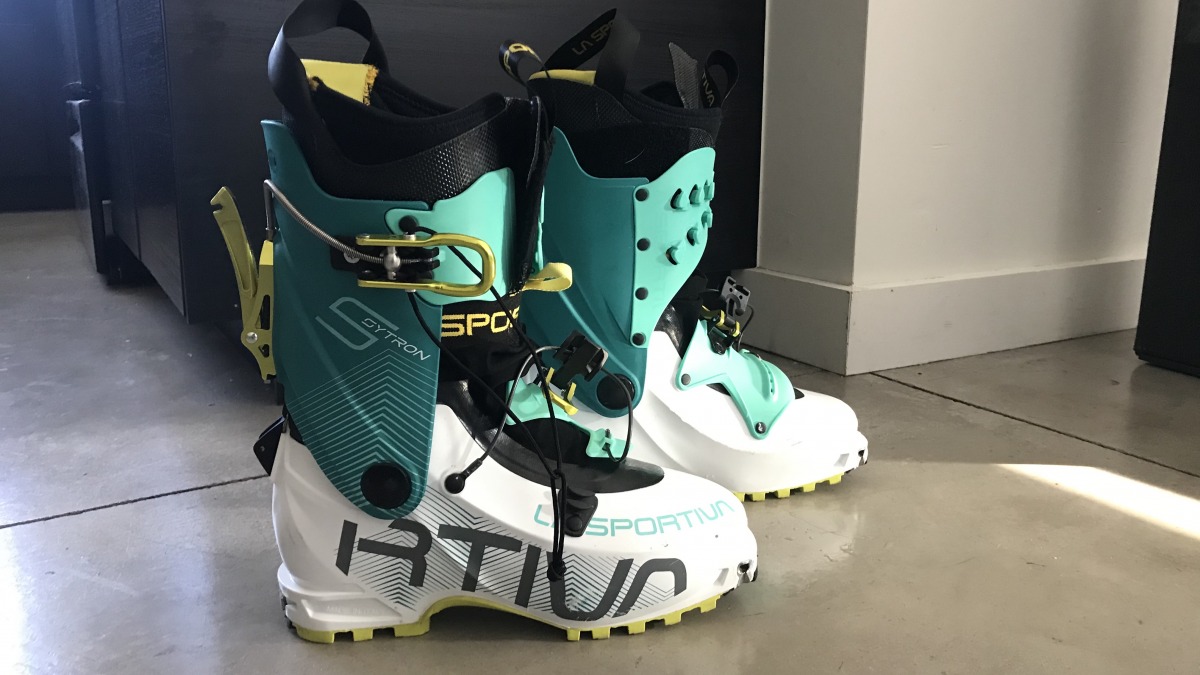
The boots pack a lot of features into a light package, including burly soles, forward lean options, and efficient closure systems. The color is cute too.
The La Sportiva Sytron is situated in a healthy class of ski mountaineering boots including Alien RS, Atomic Backland UL and the Dynafit PDG 2. While not designed explicitly for Rando racing, these boots can easily cross over into rec-race territory but not be pigeonholed into spandex missions only.
Features
The carbon enforced Grilamid shell is stiff, abruptly so. I was happy to really push into it on my first few days out and feel it solidly beneath my shins. The flex certainly isn’t progressive but is something to lean into that doesn’t fold over. Four forward lean positions, (14 — 20 degrees), provide a surprising number of options to customize the performance of what otherwise is a minimal boot.
La Sportiva provides its own wrap liner that cradles the foot and ankle and is finished with a water resistant upper and velcro closure. I liked the shape and extra security of the velcro, but otherwise I found it to be a bit thin and cold. During the early days of skiing and fitting the boots, I often felt like my heels and toes were actually rubbing against the plastic shell through the liner. Not surprisingly, the thin liner scores low on warmth.
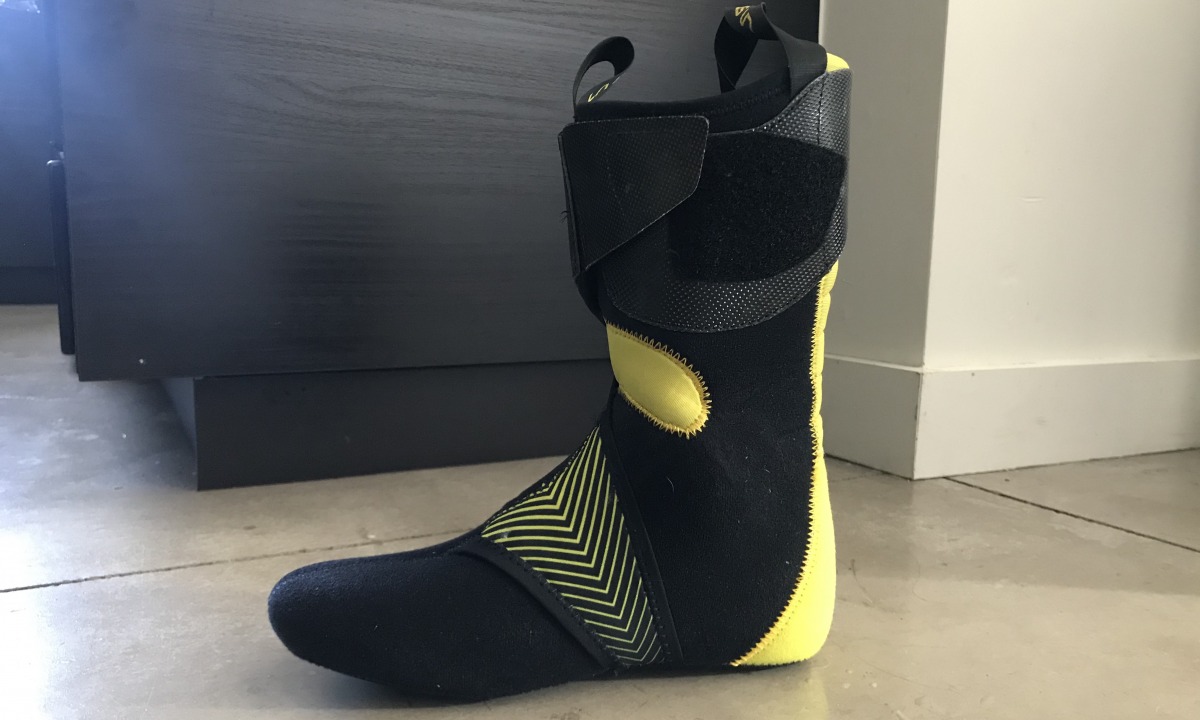
La Sportiva’s wrap liner. A bit thin and cold for my taste though I like the velcro closure.
At 75 degrees (35 in the back, 40 in the front), the range of motion closely resembles what you would have in a running shoe — that is, totally unrestricted movement. Prior to this boot, I hadn’t realized just how much resistance other touring boots have, even with wide ROM. The Styron gave a new definition to mobility, and it was particularly noticeable while skinning across long flats and slight downhill sections. With the right fit, it has potential as a truly all day, all terrain mountaineering shoe.
The Spider Buckle Evo system and CavoBike Lever mechanism are two of my favorite features. The Spider Buckle equalizes pressure across the forefoot, providing a comfortable uniform snugness I’ve not experienced in either single buckle closures or boa systems. The CavoBike walk-ski mechanism makes transitions a breeze; it looks cool too. Simply set the top buckle (via a string closure, not my favorite feature as it was prone to shift around and get caught up in the plastic), leave open for touring and flick closed to ski. Switching the buckle closed initiates the walk-ski lever on the back of the boot so you can easily transition in a single fluid motion.
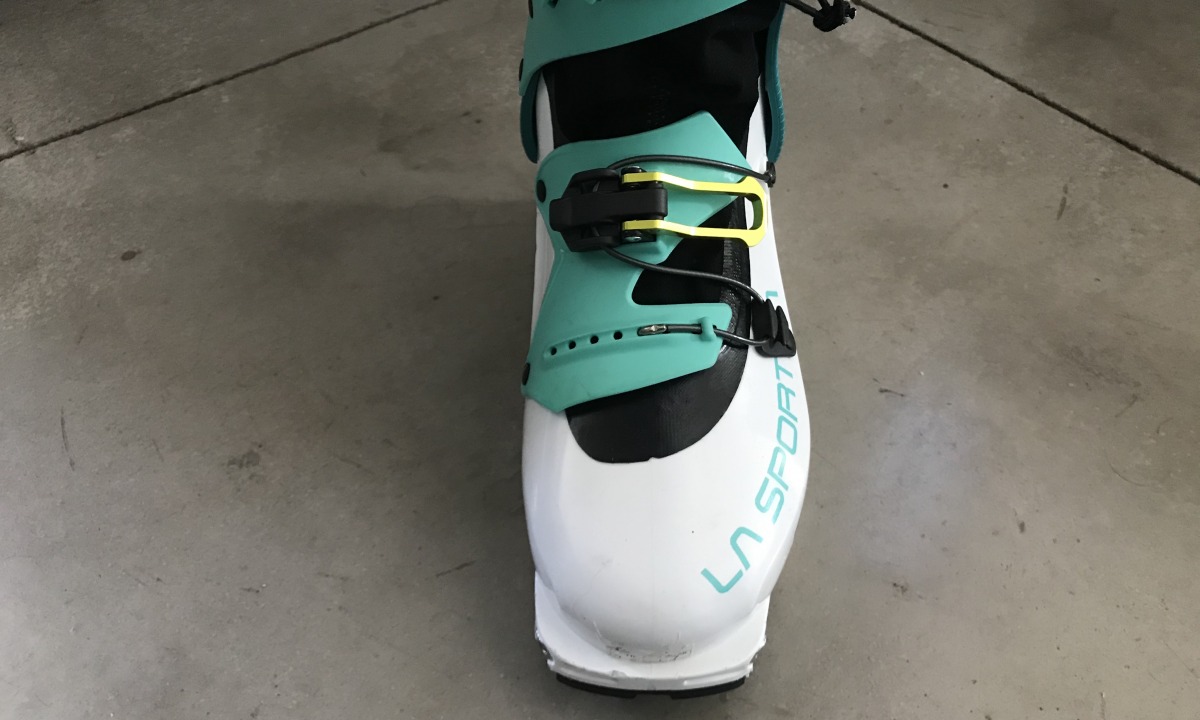
The spider buckle evo closure lends to a snug, even-pressured fit that’s easy to open up for touring (shown here) and clamp down for skiing.
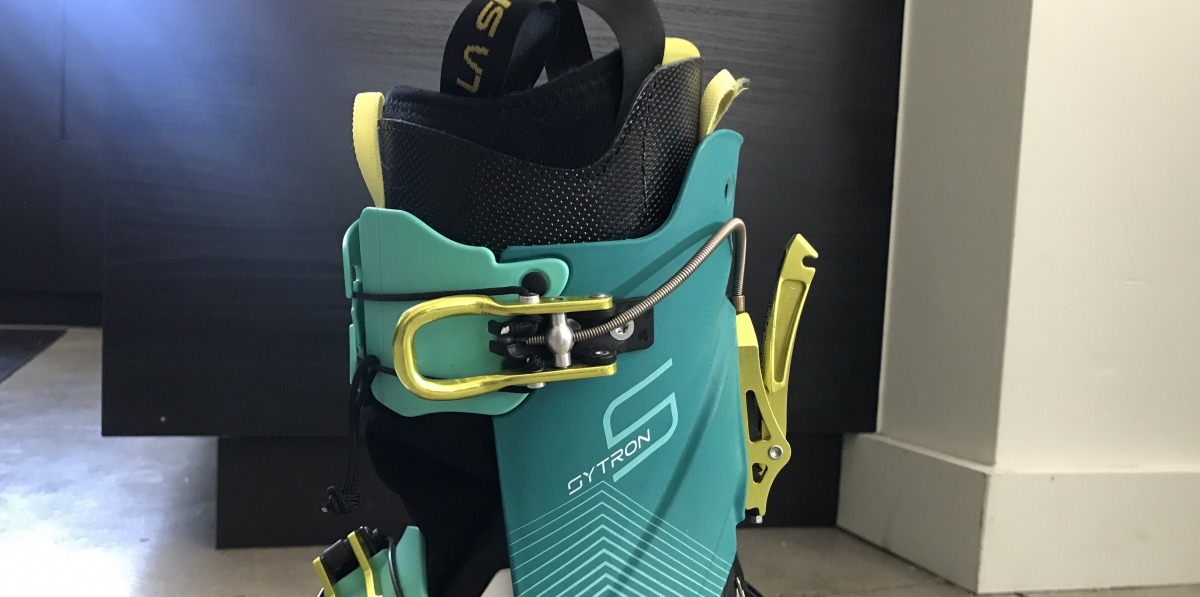
The Cavo-bike lever mechanism — easy up for walk mode…

…and down for ski mode.
Fit
With its 100.4 last, the boot fit my 99mm wide foot just fine across the top and sides. Unfortunately that’s where the out of box comfort stopped. I shell sized correctly for 25 size but something in the taper of the toe box made for a particularly challenging fit. My big toes on both feet constantly felt crunched, though my little toes had enough room. I also experienced painful rubbing on my heels, likely due to slight protrusions that have formed over years of skinning.
Several boot fitting trials and errors ensued. A standard heat mold was the first step, with toe caps and a foam wedge to take pressure off my left heel. After several weeks of hoping I’d better the fit just by wearing the boots frequently, I attempted punching the toe box. That still didn’t quite do the trick and with the 2020 Elk Grand Traverse looming, I was ready to take invasive measures. An aggressive punch fully opened up the toe box, and was followed by another heat mold with double toe caps. Finally the boots were dialed (just in time for the GT to get cancelled, alas). Fortunately the Grilamid is easy to work with. (Note: this is quite different than Alex Lee’s fit experience. It’s worth reading his review for another take).
Uphill performance
By mid-March this winter, I had logged well over 100,000 of those vertical feet I was singing about, much of it done in the Sytrons. Despite the tricky fit, I often chose them over other touring boots because the uphill efficiency was so superior. Between the low gram weight and high range of motion, the Sytrons make ascending easy — without thought, I can efforlessly lengthen my stride, swing around for kickturns, and generally have every kind of mobility I could ask for. The Grip Guard soles do their job for rock scrambling as well and the traditional toe can accomomdate a semi or full crampon.
Downhill performance
For their weight and construction, these boots ski well. While I have most consistently paired the Sytrons with 65mm race skis, I’ve also had a few bigger days out with next year’s Black Diamond Cirque 78s which shows promise for a spring mountaineering match made in heaven (or, Europe, rather). I haven’t pushed into any wider widths yet, though suspect the boot could drive well into the mid-80s (Alex Lee concurs in his review, as he used the boot to push an 88 underfoot ski).
I appreciate the stiffness of the boot despite its lack of progressive flex. At 120 pounds I’m a relatively light person and a light skier. Bigger, more aggressive skiers may find themselves flexing through the boot, but I found it ideal for the kind of performance I was seeking. The forward lean options have allowed me to play with different adjustments. I’ve settled on 16 degrees and enjoyed skiing all sorts of conditions including powder, crud, bumps and groomers. I’m excited to employ the Sytrons full time once corn season comes around (or the Coronavirus threats subside, whichever comes first).
For the ski mountaineer and lightweight tourer looking for an efficient, light boot, the La Sportiva Sytron is a great option. In terms of uphill and downhill performance, it certainly measures up among other boots in its class. And did I mention how efficient it is on the uphill? Let the vertical feet go on.
SPECS
Sizes available: 23.5 – 26.5 (half sizes, women’s version)
Weight: 660g (half pair, size 25.5)
Shell: Grilamid
Cuff: Carbon reinforced polymer (Grilamid / Carbon)
Liner: Sytron Boot Liner
Forward lean: 4 positions (14 / 16 / 18/ 20)
Range of motion: 75 degrees (35 back / 40 front)
Buckles: 2 — CavoBike Lever Pro™ / Spider Buckle EVO™
Last: 100.4mm
Compatibility: All “tech-style” bindings only
Sole: La Sportiva Grip Guard™ (complies with ISMF standards)
Shop for it.
Manasseh Franklin is a writer, editor and big fan of walking uphill. She has an MFA in creative nonfiction and environment and natural resources from the University of Wyoming and especially enjoys writing about glaciers. Find her other work in Alpinist, Adventure Journal, Rock and Ice, Aspen Sojourner, AFAR, Trail Runner and Western Confluence.
